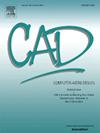基于偏好拓扑优化的虚拟现实交互式三维结构设计
IF 3
3区 计算机科学
Q2 COMPUTER SCIENCE, SOFTWARE ENGINEERING
引用次数: 0
摘要
创新的承重结构往往出现在创造性形式和工程原理之间的良好平衡。虽然基于偏好的拓扑优化方法通过考虑设计师的几何偏好来实现先进的结构设计,但它们难以可视化和编辑复杂的3D细节,这对不同的设计选项至关重要。为了克服这一瓶颈,本文提出了基于主观偏好的双向进化结构优化(ISP-BESO)方法。该方法引入了一个相似性约束,使得在优化结构中对主观偏好的精确控制成为可能。然后,提出了一种将虚拟现实与拓扑优化相结合的设计探索策略,以实现理想的三维结构的交互创建。该策略采用VR雕刻提供沉浸式可视化和实时反馈,指导优化过程中的材料重新分配。这个工作流可以迭代地产生创新和高效的结构。在ISP-BESO中调整目标相似度将设计导向性能驱动或偏好驱动的结果。一个博物馆设计实例展示了这种策略的实际潜力。本文章由计算机程序翻译,如有差异,请以英文原文为准。
Interactive 3D structural design in virtual reality using preference-based topology optimization
Innovative load-bearing structures often emerge from a fine balance between creative forms and engineering principles. While preference-based topology optimization methods have advanced structural design by considering designers’ geometric preferences, they struggle with visualizing and editing complex 3D details crucial for diverse design options. To overcome this bottleneck, here we propose the improved bidirectional evolutionary structural optimization considering subjective preferences (ISP-BESO) method. This method introduces a similarity constraint that enables precise control over subjective preferences in optimized structures. Then, a design exploration strategy is proposed by integrating virtual reality (VR) with topology optimization for the interactive creation of desirable 3D structures. The strategy employs VR sculpting to offer immersive visualization and real-time feedback, guiding material redistribution during optimization. This workflow can iteratively produce innovative and efficient structures. Adjusting target similarity in ISP-BESO steers designs toward performance-driven or preference-driven outcomes. A museum design example demonstrates the practical potential of this strategy.
求助全文
通过发布文献求助,成功后即可免费获取论文全文。
去求助
来源期刊

Computer-Aided Design
工程技术-计算机:软件工程
CiteScore
5.50
自引率
4.70%
发文量
117
审稿时长
4.2 months
期刊介绍:
Computer-Aided Design is a leading international journal that provides academia and industry with key papers on research and developments in the application of computers to design.
Computer-Aided Design invites papers reporting new research, as well as novel or particularly significant applications, within a wide range of topics, spanning all stages of design process from concept creation to manufacture and beyond.
 求助内容:
求助内容: 应助结果提醒方式:
应助结果提醒方式:


